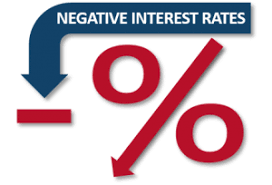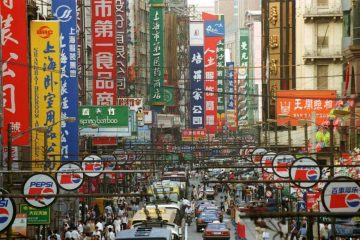What Are Negative Interest Rates and Why is Everybody So Worried About Them?

While the yield curve inverted last week, something else is developing that may be more ominous for the financial markets: negative interest rates.
Bloomberg reported that there is now $ 16 trillion worth of global negative interest rate debt. If Paul Revere were alive today and rode his horse down the Main Streets of America shouting, “Negative interest rates are coming! Negative interest rates are coming!” most people would be alarmed, but they wouldn’t have any idea how to react. “Negative interest rates? What do we do? Is that good or bad?” The answer is: It’s both, depending on who you are. But the downside is so negative that most of Wall Street and Washington will do whatever they can to avoid it.
Here’s the good side. Imagine getting a mortgage where the bank pays you interest each month, not the other way around. That’s actually going on right now in Denmark. Granted, it’s only on their 10-year mortgage, but even their 20-year mortgage is being offered at zero percent. And while they’ll probably make some money on fees related to processing the mortgage, and then make money on selling the mortgage itself to another financial institution (there are still monthly payments on the capital), it’s a big change from the customer paying the bank interest each month.
Why would banks do this? To spur you to borrow money. If their money just sits in the central bank (like the Federal Reserve) where they keep their excess reserves, they would have to pay to keep it there. It’s a role reversal. In normal times, the central bank pays them. But the central bank doesn’t want your local bank’s money. It’s better to get the money into your hands to create some velocity of money flowing through the economy.
That’s created when you take the money, hire a local contractor, who hires some guys who know how to put an addition onto a house, including one with a John Deere front loader who can do some excavation work, and a carpenter who goes to the local Home Depot to buy supplies, and Home Deport puts in an order in for more lumber, hammers and nails, and with more money in their hands, the workers go to the restaurant down the street for lunch, and after work open checking and savings accounts at the local bank, where they might even want a new credit card and a mortgage, and maybe even some money to start their own contracting business, and so on. End Scene.
Here’s the bad side. What if people still don’t borrow money (even at extremely low rates) and the money just sits there? That leads to a dangerous ‘wait and see’ change in psychology. There’s no inflation, so what’s the hurry? People don’t borrow money. They don’t hire local contractors. They don’t go out to eat as often. They don’t go on the trips they used to take during summer. It’s an entirely different cycle and no institution that makes money by lending money wants that to happen. Right now Japan, France and Germany are among several countries that can sell negative interest rate bonds around the world, and there are signs that the negative interest rate phenomenon could be coming to the United States.
“Negative rates are like a fever,” says Nancy Davis, Managing Partner & Chief Investment Officer at Quadratic Capital Management. “By themselves they don’t necessary mean anything. But they’re a symptom of a global shortage of duration and high quality assets.” In other words, for investors looking for safety over the long term, it’s not about earning a return on their capital, but return of their capital. U.S. treasuries are considered a leading safe haven because of the stability of the American economy and the ability of the government to make good on its obligations. That accounts, at least in part, for the falling yield on U.S. debt.
But the nightmare scenario is the D word. Two of them. Deflation and depression. If people don’t borrow money, even if they’re paid to do so, that would lead to a slowing economy. It could mean people put off purchasing houses or making additions to them, and companies laying off workers. When that’s multiplied by the thousands, which becomes millions, it could mean recession. If the cycle continues beyond a brief time, it could become a depression. Already hours worked are starting to come down, and that very possibly could be followed by job cuts. And that’s something the Federal Reserve wants to stop in its tracks so it will probably lower its own interest rates significantly in the coming weeks. Ideally, that will help get the yield curve back to normal—where lower rates are lower than longer term rates—and hopefully stave off a recession. (Last week’s inversion was temporary, but the spread is still thin.)
In the institutional world, money managers want to return to a normal yield curve as well. If rates go down too far, they’ll have to look for positive return somewhere else. Nancy Davis says that will create volatility: “It creates speculative behavior. They still need yield and income, so it pushes them into riskier assets. It’s well meaning, but the reality is that it’s almost like heroin and they might not be able to stop. They keep looking for return, and they take riskier and riskier positions to get it.”
What are the remedies?
Davis says, “We need to do a reverse TWIST operation.” She’s referring to a program In 2011 when the Federal Reserve sold short-term Treasury bills to buy long-term Treasury debt. The higher demand for the longer term debt pushed interest rates downward. That made borrowing cheaper, encouraging borrowers to put the money to work in the economy. By most counts, it worked.
A reverse TWIST operation would do the opposite: the Federal Reserve would sell long term debt, and buy short term debt. That would accomplish the opposite with yields: short term rates would fall, and long term rates would go up. It’s another tactic to get the yield curve back to normal, and to avoid negative rates. And it would hopefully create an expectation that inflation would go up in the future, which would encourage you to borrow money now, and put the money to work in the economy. Normal yield curve. Normal interest rates. Normal inflationary expectations. Normal behavior. Normal economy. All is well.
But not everybody believes that a change in monetary policy is the solution. In fact, some feel easy money has been one of the problems. “Negative interest rates would indicate that monetary policy is, in essence, impotent,” says Phillip Braun, professor at Kellogg School of Management.
Lowering rates too soon, and too far, would take away ammunition to fight a slowing economy in the future. Considering The Fed Funds Rate is only 2.25% right now, there’s not a long way to go. “The Fed needs room in the future to institute policy responses, when interest rates truly need to be pushed lower,” Braun says. “The Fed should avoid negative interest rates by not pushing interest rates lower now to accommodate President Trump’s trade war with China.”
He’s not sure what should be done if interest rates really do turn negative. “The best that can be said is, given negative interest rates, at any sign of economic growth, the Fed should immediately start raising interest rates, even if there are some negative consequences.”
Another approach to get back to normal, and avoid negative rates in the long run, was floated by the Treasury department last Friday. It would offer ultra long debt, 50-year or 100-year bonds. By Monday the 30-year bond yield was already rising, pushing the yield curve back to normal. It’s a topic that will no doubt come up when central bankers gather for their yearly convention in Jackson Hole, Wyoming.
Which brings us back to Paul Revere and Americans not knowing what to do with negative rates. The consensus seems to be all efforts to avoid them. If Germany and Japan are any indicators, negative rates usually go along with slower economic growth as well.
Individual investors in those countries had a curious, if logical, response when Germany and Japan went negative several years ago. Cash become king, and many people who lost faith in the system didn’t leave their money in the banks. And they didn’t stash it under the mattress. They bought safes—a record number of them.
More must-read stories from Fortune:
—This recession indicator is going off—but don’t use it to time the market
—The death of trading: Why more big banks think the business is a losing bet
—Business confidence is plummeting because of a “chaotic” environment
—How are big banks doing when it comes to diversity? Congress isn’t impressed
—“Negative” interest rates used to be unthinkable in the U.S.—not anymore




